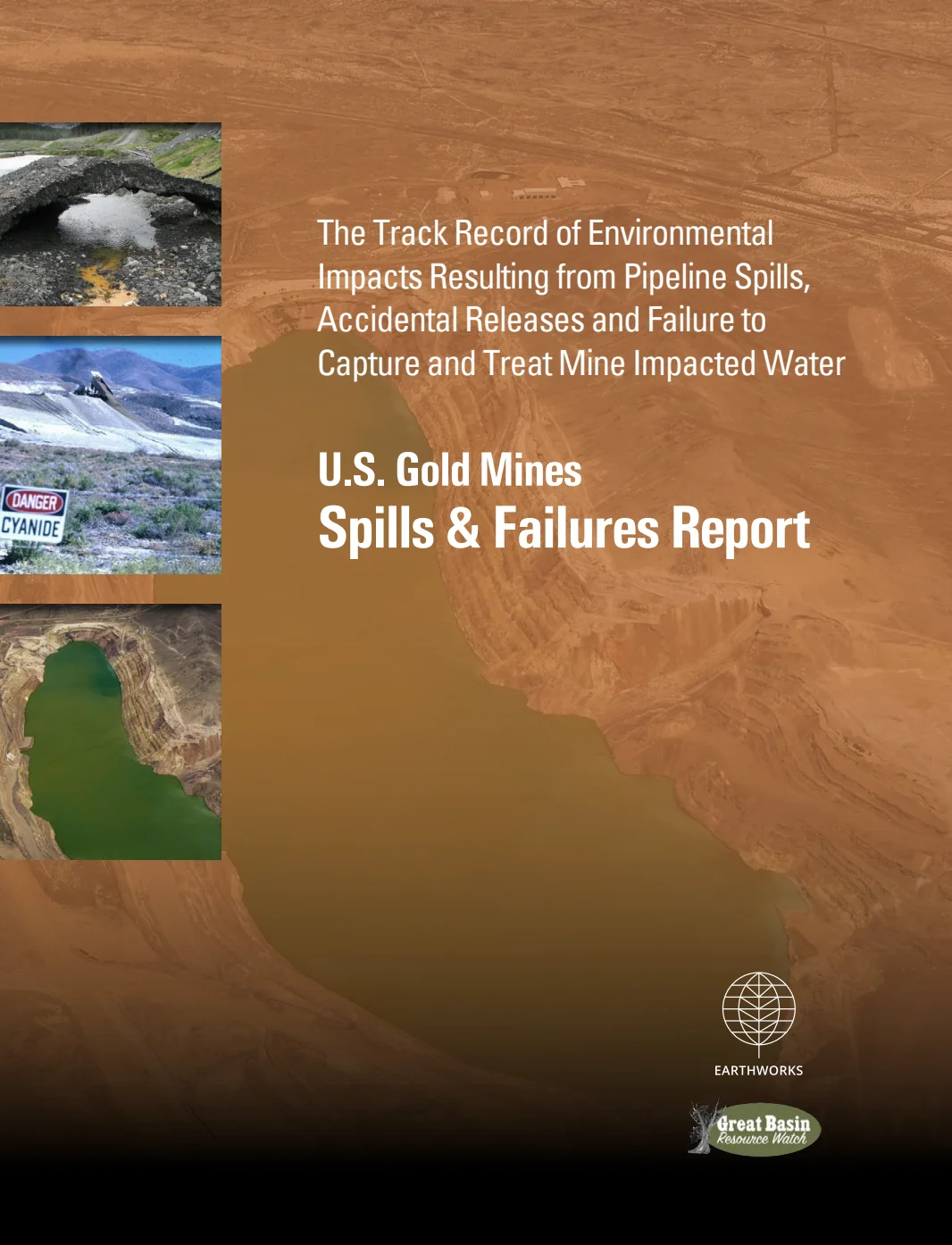From the Report:
Our research determined that 100% of the mine operations reviewed in this report experienced at least one failure, with most mines experiencing multiple failures.
- 27 of the 27 mining operations (100%) have experienced at least one pipeline spill or other accidental release, such as spills of cyanide solution, mine tailings, diesel fuel, and ore concentrate.
- 20 of the 27 mining operations (74%) have failed to capture or control contaminated mine seepage. The seepage of cyanide solution was one of the more common impacts. The development of acid mine drainage was associated with some of the most lasting impacts.
- Water quality impacts to surface and/or groundwater were identified at 20 of the 27 mining operations (74%), including impacts to drinking water supplies for residential homes and businesses, loss of fish and wildlife habitat, and fish kills.
- Water quality impacts were not identified at 7 out of 27 mining operations. At 6 of those 7 mines (86%), no perennial streams were present in the project area and groundwater was generally deep.
Research shows that mines with high acid generating potential and in close proximity to surface and groundwater are at highest risk for water quality impacts. Availability of water is key to the development of acid drainage and the extent of containment. Many of the currently operating gold mines are located in the arid southwest, where precipitation is low (often less than 10 inches per year). Thus, the potential for surface precipitation to carry contaminants to the groundwater is significantly limited. Acid mine drainage will require water treatment and capture in perpetuity at the Bingham Canyon Mine, Golden Sunlight Mine, and Phoenix Mines, among others.
At 6 of the 7 gold mines where water quality impacts were not identified (e.g., Bald Mountain, Ruby Hill, Mineral Ridge, Mesquite, Denton/Rawhide, Turquoise Ridge) no perennial streams are present in the project area and groundwater is generally deep (>250 feet). For example, at the Denton Rawhide mine in Nevada, groundwater is so deep that it has not been located and there is no surface water within five miles of the mine. Impacts to ephemeral streams, where water flows only briefly after rainfall events, are more difficult to assess. Monitoring opportunities are limited, and in some cases ephemeral streams are not protected by the provisions of the Clean Water Act. For example, at the Mineral Ridge Mine, the ephemeral streams in the mine area were determined to be non-navigable, and therefore, not subject to the water quality protections and monitoring requirements provided by the Clean Water Act.
The ability to fully realize the extent of impacts is hampered by the limitations of monitoring. Often seepage from tailings or other mine facilities are recognized by a visual inspection of the containment dam. However, seepage can and has occurred from portions of a facility that are not monitored or difficult to monitor. In many cases, documentation of the failure does not occur until contamination reaches the nearest down gradient water monitoring point. As stated above, the depth to groundwater can be great and there is the potential that a containment failure could occur and not be noticed until after the mine is closed. Despite the incorporation of leak detention systems, which are applied at most new mines, (regulations vary from state to state) many failures of containment occur beyond detection.
CONCLUSION
The evidence is clear: modern gold mining in the U.S. poses significant and ongoing risks to water quality and environmental health. All 27 mining operations reviewed experienced at least one major containment failure, with many reporting multiple incidents, including pipeline spills, seepage of cyanide solutions, and unmonitored contamination pathways. Nearly three-quarters of these operations failed to control contaminated mine seepage, and a similar proportion caused detectable harm to surface or groundwater.
These failures are not isolated or anomalous—they are systemic. The use of cyanide leaching, unlined tailings impoundments, and aging or compromised containment systems routinely leads to the release of toxic substances into surrounding ecosystems. Even in arid environments where water is scarce, groundwater remains vulnerable due to deep seepage and the long-term persistence of pollutants.
Monitoring limitations, regulatory loopholes, and inconsistent reclamation practices further compound the issue, allowing contamination to go undetected until irreversible damage occurs—often long after mine closure. The threat is especially acute where acid-generating rock is present, as the formation of acid mine drainage can persist for decades or even centuries.
If gold mining is to continue, it must be held to far stricter environmental standards, with robust, enforceable regulations, long-term monitoring, and fully funded reclamation plans. Without these protections, the cost of gold will continue to be borne not just by the land, but by the communities and ecosystems downstream.

